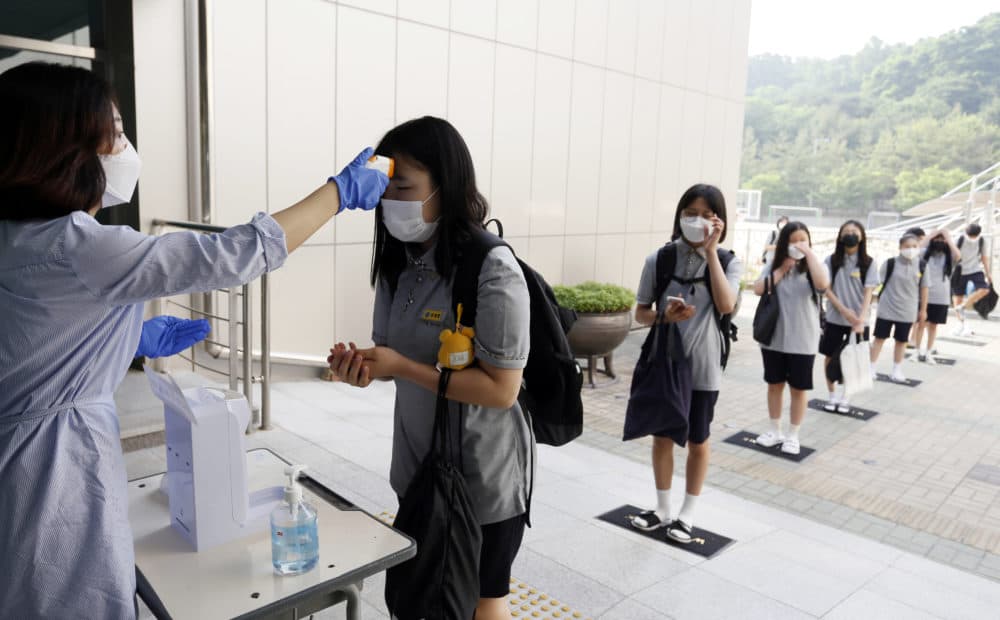Advertisement
Commentary
We All Want Schools To Reopen Fully. That Doesn't Mean They Should

Tenth grade English students take turns reading a poem aloud. They’ll write responses to the poem’s last line and share them in small groups. Homework is to write a poem emulating the author's style. Another class watches a film together in real-time, and analyzes the dialogue, or the product placement, or gender roles. A ninth-grade history class chooses a news story; students watch FOX News and CNN to study the differences in coverage — intent, focus, discourse style. Environmental science students watch the sunrise or sunset weekly, and record impressions and data points in a journal. In a music class, working musicians are guest speakers, and students play with them live.
All of these high school classes have happened, or could, online.
Distance learning is far from perfect. (Everything about this pandemic is so far from perfect.) But it’s where we should be putting our focus and resources for September. Despite Donald Trump’s impulsive and politicized calls to reopen schools or else, and other, more well-reasoned rationales for doing so, the idea that we could and should send kids back to school six weeks from now, even in Massachusetts, seems untenable.
The state’s reopening guidelines read as both too prescriptive (devise three different plans, by July), and too lenient (maybe three feet of distance is enough — do what you can). It’s up to local school officials to sort it out. But it will be teachers taking both the heat and the risk. As one teacher friend said, “It feels like we’re arranging desks on the Titanic.”
I taught high school English for 25 years. I’m also the mother of two teenagers — a rising 11th grader and a college freshman set to start in person in January. I hate the idea of my kids’ and their peers’ education being paused. Even as I write this, I’m torn, weighing the risks and debating with myself. And yet, the idea of reopening schools amidst dire predictions, with no national plan is bewildering.
It reminds me of that "Seinfeld" episode where the waitress warns Elaine that a plate is hot. Elaine touches the plate. When the waitress asks her why, she says “I just wanted to see what your idea of hot was.” In the case of COVID-19, we know the science. We know how hot the plate is.
As one teacher friend said, “It feels like we’re arranging desks on the Titanic.”
Still, and understandably, many parents want schools reopened. The concerns are valid and multifaceted: Kids are depressed. They may be falling behind. Parents who don’t have childcare can’t work. Online learning isn’t robust enough yet.
People in favor of reopening for the sake of kids’ mental health are making the assumption that kids who are isolated and anxious at home will feel connected and relieved to be back at school. This assumption hopscotches over a few difficult and unpleasant truths. Kids won’t be getting back to the schools they left in March. Schools that by definition and decree must be low-contact — with masks, small cohorts, quarantines, no clubs and little socializing — sound frustrating and alienating. And kids carry the additional burden of worrying about the harm they could bring to their families and teachers by making simple, honest mistakes like going in for the hug without thinking, forgetting a mask, sharing food, sneezing in the bathroom, etc.
Research shows the importance of connection in school. But there is nothing magical about a school building without the social connections that happen inside it. If we send kids to school without the ability to connect with their teachers, or the chance to interact socially and eat lunch with their friends, how connected will they really feel?
There is no replacing the pre-pandemic classroom’s daily intimacies: the personalities in (mostly) wonderful combustion; the messy and productive discourse; the communal inside jokes. In a classroom, we can notice a hawk landing on the window’s ledge and take a moment to crowd around and watch it. But even with an online-only model, we can give kids meaningful experiences with content, regular interaction with peers free from COVID-related hypervigilance, and engagement with the community through guest speakers and service work.
I wonder if we’re conflating school-related challenges with other legitimate and urgent concerns — especially regarding childcare. Subsidizing childcare at the state and district level and enlisting community volunteers around academic support seem like better places to allocate resources than the impossible task of making schools pandemic-proof by the fall.
I fear for each teacher, poised to be the canary in the coalmine, the sacrificial lamb, the test track driver heading for a cliff.
The losses associated with suspending in-person schooling have been profound. Addressing the gaps in students’ learning and social development will take collective persistence and resources. Once school buildings are safe, we’ll need to regain institutional and emotional equilibrium. Unlike the lasting damage of COVID, these losses are recoverable.
All schools have a “hidden curriculum,” — unstated values on display: how adults treat each other; who gets disciplined; how kids and teachers interact. The kids are watching us. When the pandemic is over, how do we want them to look back on the decisions we made? Were we brave? Did we safeguard our most vulnerable?
If we open schools in September, we’ll all do our best. But I fear for kids and for my family. I fear for each teacher, poised to be the canary in the coalmine, the sacrificial lamb, the test track driver heading for a cliff.
